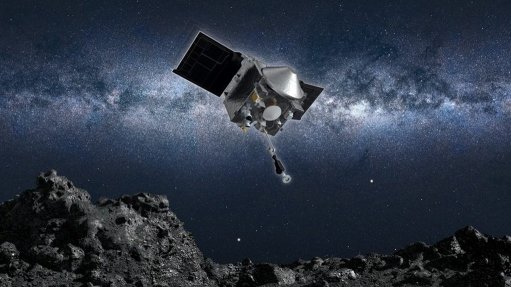
Artist’s impression of OSIRIS-REx, with TAGSMA arm extended, about to conduct its touch-and-go with asteroid Bennu
Photo by: Nasa
The US National Aeronautics and Space Agency (Nasa) has reported that its OSIRIS-REx spacecraft has successfully stowed the sample of regolith (dust and pebbles) that it had secured from the surface of the asteroid Bennu. OSIRIS-REx is an acronym for Origins, Spectral Interpretation, Resource Identification, Security, Regolith Explorer. Bennu was chosen because it is an ancient but well-preserved body, offering scientists information about the early Solar System when it was still forming, billions of years ago.
The spacecraft collected the sample during a ‘touch-and-go’ manoeuvre on October 20, using a robotic arm called the ‘Touch-And-Go Sample Acquisition Mechanism’ (TAGSAM). The aim was to collect a sample of at least 60 g. In fact, it collected a much bigger sample, much more than expected. So much, indeed, that imagery from the spacecraft showed that a mylar flap intended to keep the sample securely inside the TAGSAM collector head was unable to close properly and so some of the sample was being lost into space.
As a result, it was decided to omit a planned manoeuvre that had been intended to allow scientists to estimate the size of the sample (before the actual touch-and-go it had been feared that the TAGSAM might not collect enough material) and accelerate the sample stowage process. The TAGSAM was commanded to place its collector head inside OSIRIS-REx’s Sample Return Capsule (SRC), where the head was secured by latches in what is called the capture ring. The collector head was then mechanically separated from the TAGSAM arm. This was withdrawn and the SRC was then closed and its lid secured by two internal latches.
The complexity of these processes meant that the stowing and securing of the sample took two days. Bennu, around which the spacecraft has been orbiting since December 2018, is currently 321-million kilometres from Earth. This means that radioed commands from Earth take 18.5-minutes to reach OSIRIS-REx, and its telemetry (including imagery) take another 18.5-minutes to get back to Earth. After each step in the stowage process, the mission controllers had to wait for and then evaluate the telemetry and imagery to ensure that that step had been successful and that they could go forward with the next step.
“Given the complexity of the process to place the sample collector head onto the capture ring, we expected that it would take a few attempts to get it in the perfect position,” reported Nasa Goddard Space Flight Centre OSIRIS-REx project manager Rich Burns. “Fortunately, the head was captured on the first try, which allowed us to expeditiously execute the stow procedure.”
The next phase of the mission is the cruise back to Earth. This, however, will not start until March next year, which is when the ‘departure window’ will open for the most fuel-efficient voyage home. OSIRIS-REx will reach Earth in September 2024, and, when it does, it will eject the SRC, which will then parachute down into the US state of Utah’s West Desert, where it will be collected.
“I’m very thankful that our team worked so hard to get this sample stowed as quickly as they did,” affirmed University of Arizona, Tucson, OSIRIS-REx principal investigator Dante Lauretta. “Now we can look forward to receiving the sample here on Earth and opening up that capsule.”